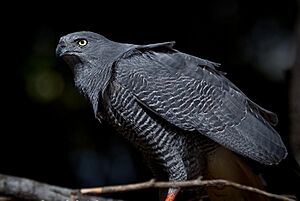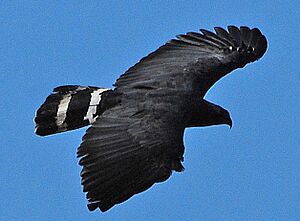Crane hawk facts for kids
Quick facts for kids Crane hawk |
|
|---|---|
 |
|
| Conservation status | |
| Scientific classification | |
| Genus: |
Geranospiza
|
| Species: |
caerulescens
|
 |
|
The crane hawk (Geranospiza caerulescens) is a special type of bird of prey. It belongs to the family Accipitridae, which includes eagles, hawks, and kites. This bird is the only species in its group, called Geranospiza.
Contents
About the Crane Hawk
Scientists used to think there were many different types of crane hawks. But now, they agree it's just one species. Different groups of these birds are now called subspecies. They look a bit different depending on where they live.
The crane hawk is a great example of something called convergent evolution. This means that two different animals, like the crane hawk and the African harrier-hawks, developed similar body parts or behaviors. They did this because they live in similar ways, even though they are not closely related.
Crane Hawk Subspecies
There are six recognized subspecies of the crane hawk:
- G. c. livens – found in northwest Mexico
- G. c. nigra – lives from Mexico to central Panama
- G. c. balzarensis – found from east Panama to northwest Peru
- G. c. caerulescens – lives from east Colombia to the Guianas, east Peru, and Amazonian Brazil
- G. c. gracilis – found in northeast Brazil
- G. c. flexipes – lives from south Brazil to Paraguay, Bolivia, north Argentina, and Uruguay
Where Crane Hawks Live
Crane hawks live in warm, tropical areas. They prefer lowlands at the edge of forests. You will almost always find them close to water.
These birds are found in many countries across Central and South America. This includes Argentina, Belize, Bolivia, Brazil, Colombia, Costa Rica, Ecuador, El Salvador, French Guiana, Guatemala, Guyana, Honduras, Mexico, Nicaragua, Panama, Paraguay, Peru, Suriname, Trinidad, Uruguay, and Venezuela. They sometimes move around to new places. This often happens when water conditions change.
How Crane Hawks Behave
Crane hawks are very good at finding food. They often look for prey from a high spot, like a tree branch. Then, they swoop down to catch it. They also hunt while flying.
Unique Hunting Skills
These hawks have a special trick! Their tarsal bones (part of their legs) are very flexible. This allows them to reach deep into tree holes and pull out hidden prey. It's like having "double-jointed" legs. The African harrier-hawks also have this amazing ability.
What They Eat
Crane hawks eat many different small animals. Their favorite foods include rodents, bats, lizards, snakes, frogs, and small birds. They especially like baby parrots and woodpeckers still in their nests. They also eat larger insects like beetles, cicadas, and cockroaches. Sometimes, they will eat spiders, other arthropods, and even snails.
Nesting and Eggs
When it's time to have babies, crane hawks build their nests high up in tree canopies. They often choose spots in clumps of orchids or other plants that grow on trees. The nest is a shallow cup made of twigs. It can be anywhere from 10 to 25 meters (about 33 to 82 feet) high in a tree. Female crane hawks usually lay 1 or 2 eggs. The eggs are white or have a bluish tint.
Conservation Status
The crane hawk is not super common anywhere. However, it is found in many different places. This wide distribution helps protect the species.
In some areas, the crane hawk faces more challenges. For example, it is considered threatened in Mexico. It is even endangered in El Salvador. But in Argentina, it is at a low risk of disappearing.



